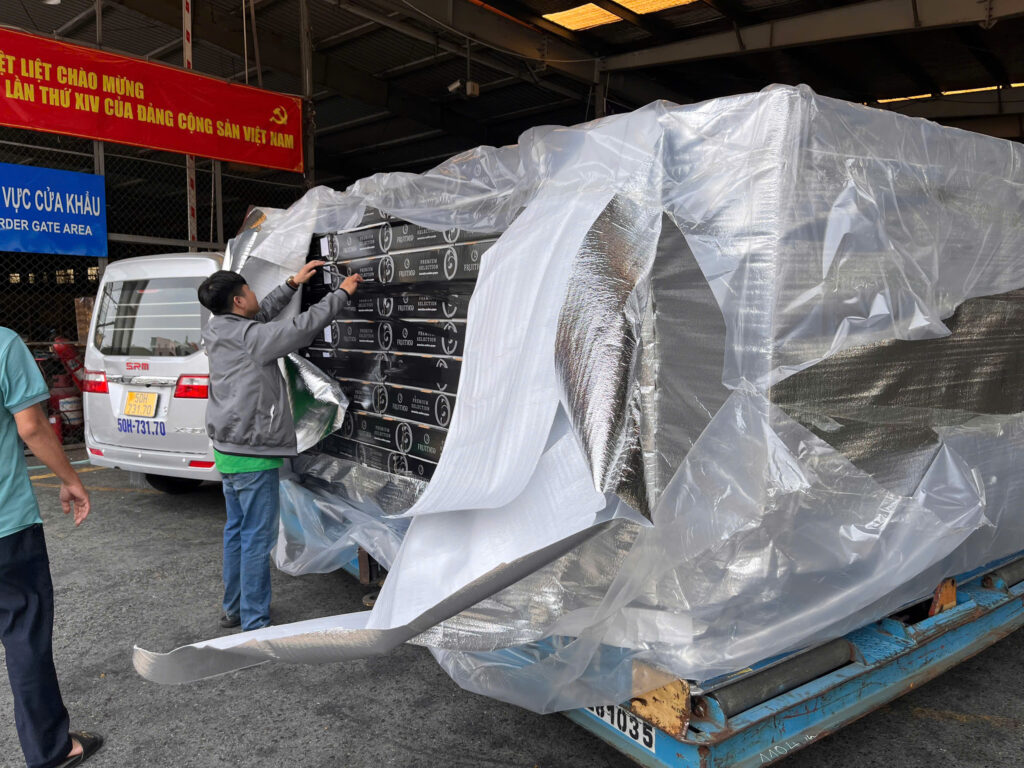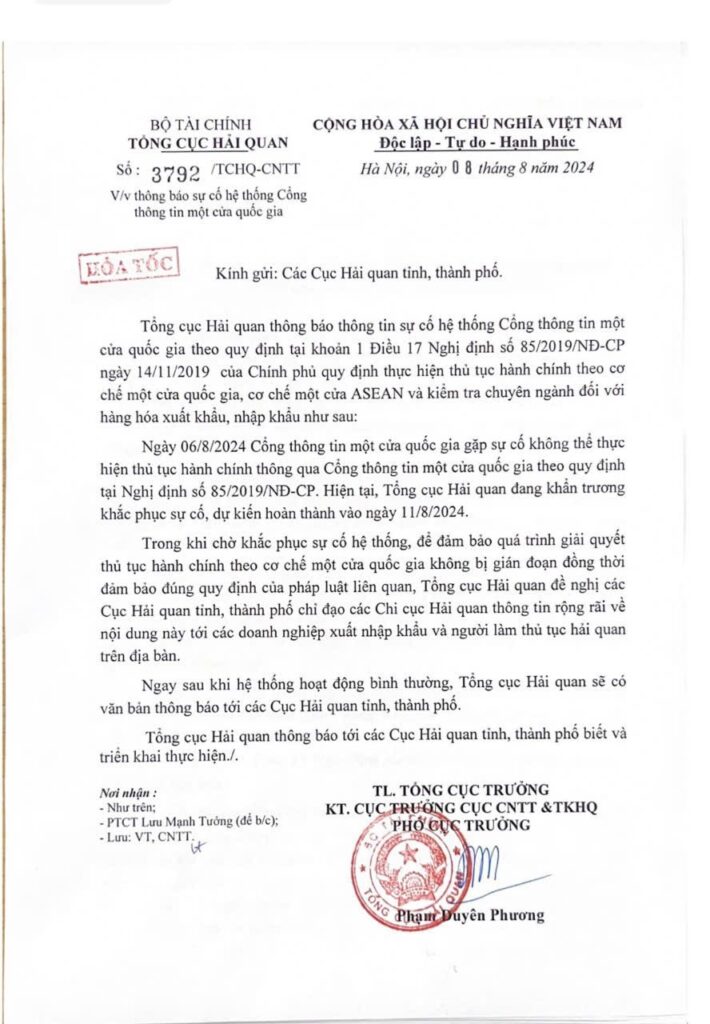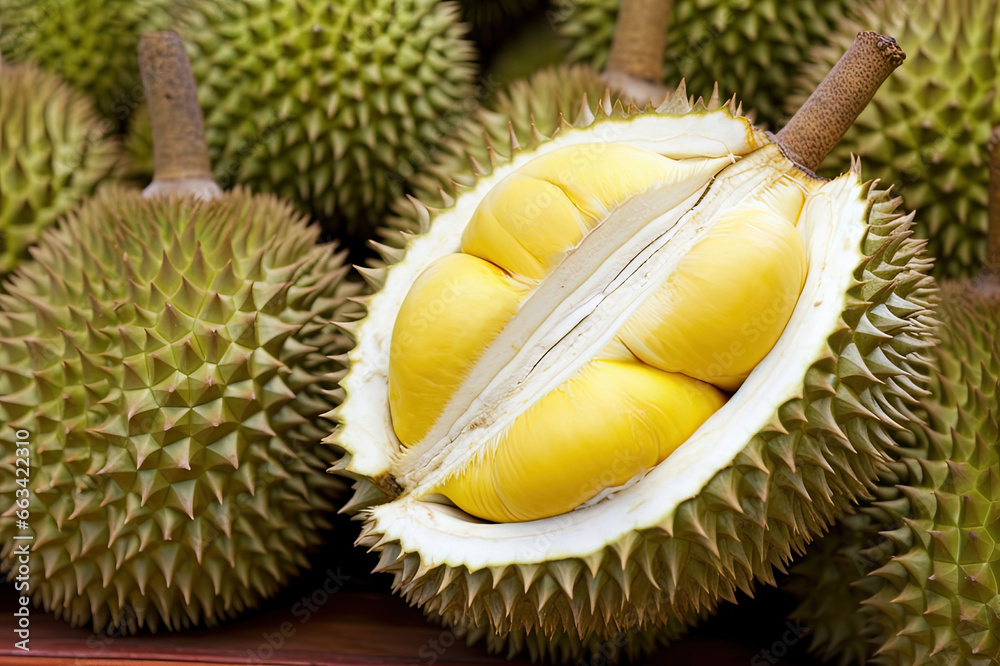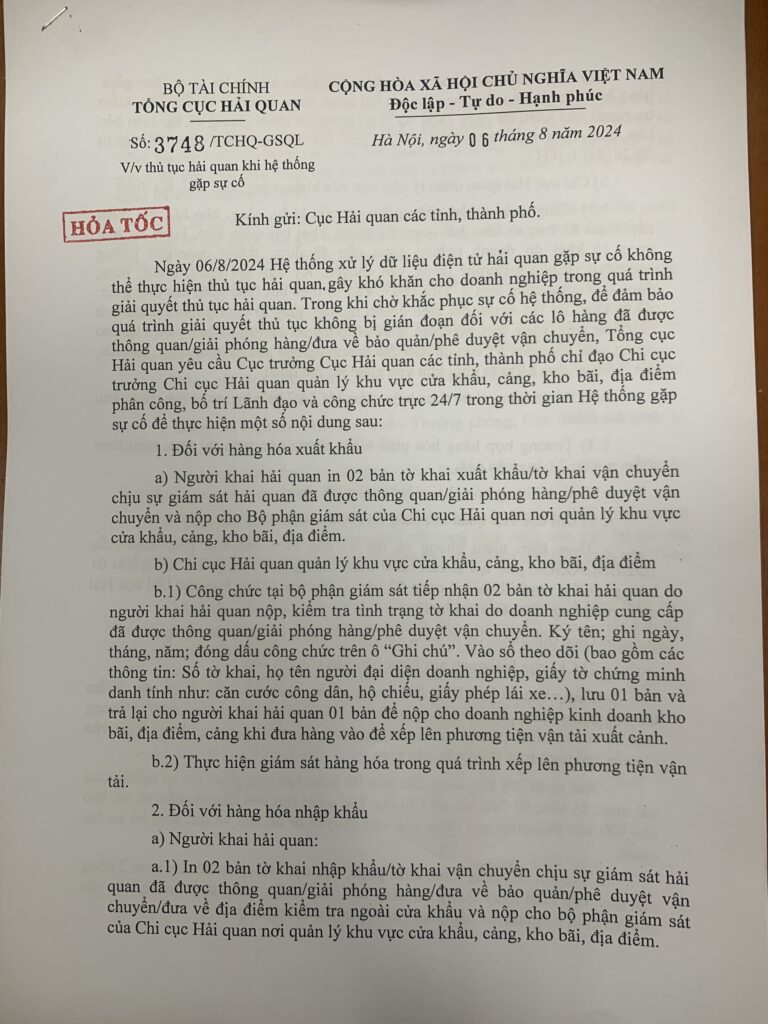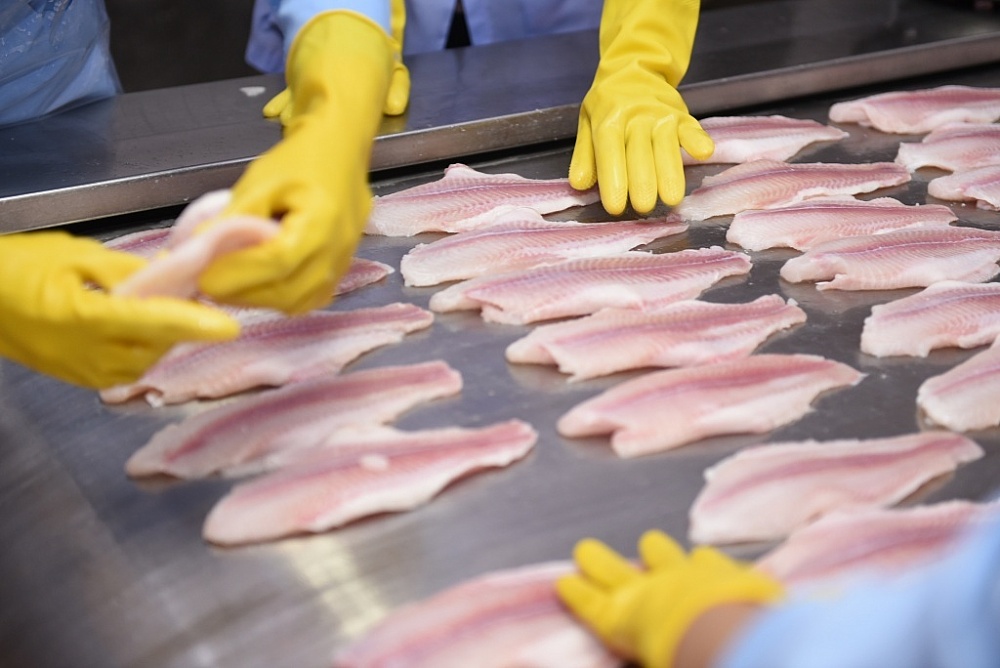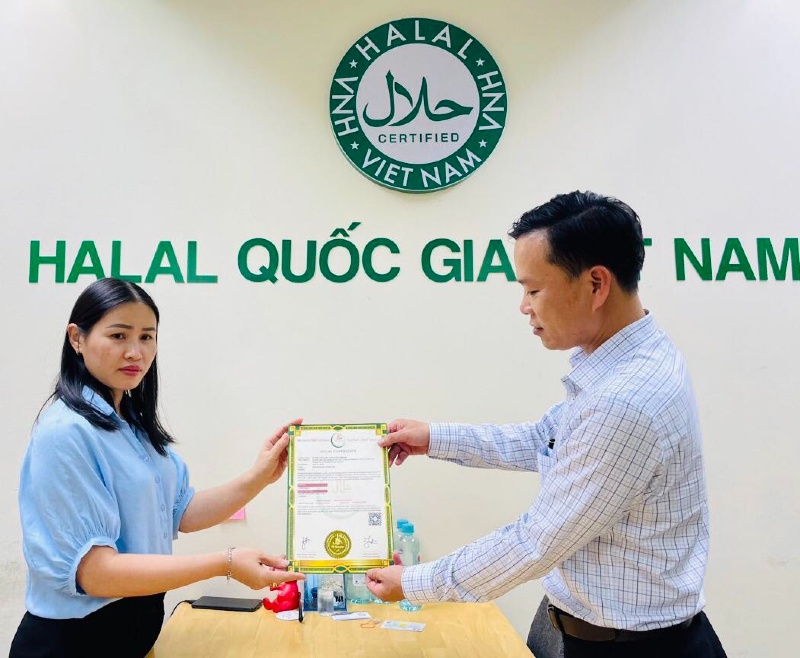|
GOVERNMENT |
SOCIALIST REPUBLIC OF VIETNAM |
|
No: 43/2017/ND-CP |
Hanoi, April 14, 2017 |
Base Law on Government Organization June 19, 2015;
Base Law on product and goods quality November 21, 2007;
Base Commercial law June 14, 2005;
Base Act to protect the interests of consumers November 30, 2010;
At the request of the Minister of Science and Technology;
The Government promulgates a Decree on goods labels.
1. This Decree regulates the content, recording method and state management of labels for goods circulated in Vietnam and imported goods.
2. The following goods are not regulated by this Decree:
a) Real estate;
b) Temporarily imported goods for re-export; goods temporarily imported to participate in fairs and exhibitions then re-exported; goods in transit, goods transferred from border to border; transshipment goods;
c) Luggage of people leaving or entering the country; moveable assets;
d) Confiscated goods sold at auction;
d) Goods are fresh, raw food, processed food without packaging and sold directly to consumers;
e) Goods are fuel, raw materials (agricultural products, aquatic products, minerals), construction materials (bricks, tiles, lime, sand, stone, gravel, cement, fertile soil, mortar, concrete mixture commercial products), scrap (in production and business) without packaging and sold directly to consumers;
g) Goods are petroleum, gas (LPG, CNG, LNG), liquid, bulk cement without commercial packaging in containers or cement tanks;
h) Used goods;
i) Exported goods are not consumed domestically;
k) Goods in the field of security and defense; Goods that are radioactive substances, goods used in emergencies to overcome natural disasters and epidemics; means of transport by rail, waterway, and air.
Article 2. Subjects of application
This Decree applies to organizations and individuals producing and trading goods in Vietnam; Organizations and individuals importing goods; state agencies; relevant organizations and individuals.
Article 3. Explanation of terms
In this Decree, the following terms are understood as follows:
1. A goods label is a written, printed, drawn, photocopied copy of words, drawings, or images that are pasted, printed, attached, molded, engraved, or engraved directly on the goods or the commercial packaging of the goods. or on other materials attached to the goods or commercial packaging of the goods;
2. Labeling of goods means expressing basic and necessary content about goods on the label for consumers to recognize and serve as a basis for selection, consumption and use; for manufacturers, traders, to inform and promote their goods and for authorities to carry out inspection and control;
3. Original label of goods is the label displayed for the first time by the organization or individual producing the goods attached to the goods or commercial packaging of the goods;
4. Secondary label is a label showing mandatory contents translated from the original label of the goods in a foreign language into Vietnamese and supplemented with mandatory contents in Vietnamese according to the provisions of Vietnamese law that the original label of missing goods;
5. Commercial packaging of goods is the packaging that contains the goods and circulates with the goods; Commercial packaging of goods includes two types: Direct packaging and outer packaging:
a) Direct packaging is the packaging that contains the goods, is in direct contact with the goods, creates a shape or is tightly wrapped according to the shape of the goods;
b) Outer packaging is the packaging used to package one or several units of goods with direct packaging;
6. Simply packaged goods are goods that are packaged without the witness of the consumer so that when purchased, they can be opened and inspected directly;
7. Circulation of goods is the display, promotion, transportation and storage of goods during the process of buying and selling goods, except in the case of transportation of goods by organizations and individuals importing goods from the border gate. about storage;
8. Transshipment goods are goods transferred from the exporting country to the importing country through customs border gates and brought into transshipment areas at Vietnamese ports;
9. Quantity of goods is the quantity of goods expressed in units of measurement or by count of goods;
10. Production date is the date of completion of the final step to complete the goods or batch of goods;
11. “Expiry date” or “use date” is the period of use assigned to goods or a batch of goods after which time the goods no longer fully retain their inherent quality characteristics. .
The shelf life of goods is expressed as the period of time from the date of manufacture to the expiration date or expressed in days, months, and years of expiration. In case the expiration date only shows the month and year, the expiration date is calculated until the last day of the expiration month;
12. Ingredients of goods are raw materials, including additives, used to produce goods and exist in finished products, even if the form of raw materials has been changed;
13. Quantitative ingredients are the amount of each type of raw material, including additives, used to produce that good;
14. Instructions for use and preservation of goods are information related to usage and necessary conditions for use and preservation of goods; warning of danger; How to handle when dangerous incidents occur;
15. Warning information is information to note to ensure safety for health, property and the environment during transportation, storage, preservation and use;
16. Technical specifications include technical criteria that determine the value of use or affect the safety and health of users, the environment, and the process specified in the product's standards or technical regulations. that product or commodity.
Article 4. Location of product labels
1. The goods label must be displayed on the goods and commercial packaging of the goods in a position where, when observed, the specified contents of the label can be easily and fully identified without having to disassemble the parts. details, parts of goods.
2. In case the outer packaging cannot or cannot be opened, the outer packaging must have a label and the label must fully present the required content.
Article 5. Size of goods, size of letters and numbers on labels
Organizations and individuals responsible for labeling goods determine the size of the goods label and the size of letters and numbers shown on the goods label but must ensure the following requirements:
1. Fill in all required content as prescribed in Clause 1, Article 10 of this Decree;
2. The size of letters and numbers must be large enough to be read with the naked eye and meet the following requirements:
a) The size of letters and numbers representing measurement quantities must comply with the law on measurement;
b) In case the goods are food, food additives, pre-packaged food processing aids, the letter height of the mandatory contents on the label must not be lower than 1.2 mm. In cases where one side of the package used for labeling (excluding the border) is less than 80 cm2, the letter height must not be lower than 0.9 mm.
Article 6. Colors of words, symbols and images on product labels
The colors of letters, numbers, drawings, images, signs and symbols on the product label must be clear. For mandatory content according to regulations, letters and numbers must have a color that contrasts with the background color of the product label.
Article 7. Language for presenting product labels
1. Mandatory content displayed on product labels must be written in Vietnamese, except for the cases specified in Clause 4 of this Article.
2. For goods produced and circulated domestically, in addition to implementing the provisions of Clause 1 of this Article, the content shown on the label may be written in another language. Content recorded in other languages must correspond to Vietnamese content. The font size written in another language must not be larger than the font size of the content written in Vietnamese.
3. Goods imported into Vietnam that do not show or do not show enough mandatory content in Vietnamese must have an additional label showing mandatory content in Vietnamese and keep the original label of the goods intact. chemistry. The content written in Vietnamese must correspond to the content written on the original label.
4. The following contents are allowed to be written in other languages with Latin alphabet roots:
a) International name or scientific name of the drug for human use in case there is no Vietnamese name;
b) International name or scientific name with chemical formula and structural formula of chemicals, pharmaceutical substances, excipients, and drug ingredients;
c) International name or scientific name of the ingredient or quantitative ingredient of the goods in case it cannot be translated into Vietnamese or can be translated into Vietnamese but does not make sense;
d) Name and address of foreign enterprise related to goods production.
1. Secondary labels used for imported goods according to regulations in Clause 3, Article 7 of this Decree.
2. Secondary labels are used for goods that cannot be exported or are returned or circulated on the market.
3. The secondary label must be attached to the goods or commercial packaging of the goods and must not obscure the mandatory contents of the original label.
4. The content written on the secondary label is the original translation into Vietnamese from the mandatory content written on the original label and supplemented with other missing mandatory content according to the nature of the goods as prescribed in this Decree. . Organizations and individuals labeling must be responsible for the accuracy and truthfulness of the recorded content. The content recorded on the secondary label, including additional content, must not misunderstand the content on the original label and must accurately reflect the nature and origin of the goods.
For goods that cannot be exported or are returned and circulated on the market, the secondary label must have the bold words "Made in Vietnam".
5. The following goods do not require additional labeling:
a) Components imported to replace damaged components in the goods warranty service of the organization or individual responsible for those goods, not sold on the market;
b) Raw materials, food additives, food processing aids, components imported for production, not sold on the market.
Article 9. Responsibility for labeling goods
1. Organizations and individuals responsible for labeling goods, including secondary labels, must ensure that the labeling is truthful, clear, accurate, and reflects the true nature of the goods.
2. For goods produced for domestic circulation, the producing organization or individual must be responsible for labeling the goods.
In cases where an organization or individual responsible for labeling goods requests another organization or individual to carry out the labeling, that organization or individual is still responsible for their own product labels.
3. In case the exported goods cannot be exported or are returned or put into circulation on the market, the organization or individual that puts the goods into circulation must label them according to the provisions of this Decree.
4. For goods imported into Vietnam whose original labels do not comply with the provisions of this Decree, importing organizations and individuals must add additional labels according to the provisions of Clause 3, Article 7 and Clauses 3 and 4, Article 8 of this Decree when put into circulation and must keep the original label intact.
CONTENT AND METHOD OF LABELING GOODS
Article 10. Compulsory content must be shown on product labels
1. Product labels must display the following contents:
a) Name of goods;
b) Name and address of the organization or individual responsible for the goods;
c) Origin of goods;
d) Other contents according to the nature of each type of goods are specified in Appendix I of this Decree and relevant legal documents.
2. In case the goods belong to many groups in Appendix I or not yet specified in legal documents, based on the main uses of the goods, the organization or individual responsible for the goods shall determine the group of goods to record the contents specified in point 1. d Clause 1 of this Article.
3. In cases where the size of the goods is not enough to display all the required contents on the label, the contents specified in Points a, b and c, Clause 1 of this Article must be written on the goods label. The contents specified in Point d, Clause 1 of this Article are recorded in documents accompanying the goods and the label must indicate the place where such contents are written.
For goods that are medical equipment, the presentation of the contents specified in Point d, Clause 1 of this Article is carried out in accordance with the provisions in Appendix I of this Decree.
The name of the goods must be in a prominent and easy-to-read position on the product label. The writing of the product name must be the largest letter size compared to other mandatory content on the product label.
The name of the goods recorded on the label is set by the organization or individual producing the goods. The name of the goods must not mislead the nature, uses and ingredients of the goods.
In case the name of an ingredient is used as the name or part of the product name, the quantity of that ingredient must be recorded, except for the cases specified in Clause 4, Article 13 of this Decree.
Article 12. Name and address of the organization or individual responsible for the goods
1. Proper names of organizations, individuals and places on product labels must not be abbreviated.
2. For goods produced domestically, the name of the organization or individual and the address of the facility producing those goods must be recorded.
a) A goods production facility that is a member of an organization such as a company, corporation, corporation, association and other organizations has the right to write the name or name and address and other information of the organization. that function on the label when permitted by these organizations.
b) Goods with the same brand are produced at many different production facilities, the organization or individual responsible for the goods may have the name and address of that organization or individual written on the goods label. If the quality of the goods is consistent with the goods quality standards announced or registered for circulation by the organization or individual responsible for the goods and the origin of the goods must be traceable.
3. For goods imported for circulation in Vietnam, the name and address of the producing organization or individual and the name and address of the importing organization or individual must be recorded.
For goods that are medical equipment imported for circulation in Vietnam, write the name and address of the manufacturing organization or individual associated with the origin of the goods and write the name and address of the owner. Must have a registration number for circulation of medical equipment.
4. For goods of organizations and individuals acting as direct sales agents for foreign traders importing goods into Vietnam, write the name and address of the manufacturing organization or individual and the name and address of the organization. organization or individual acting as an agent to sell those goods.
5. For goods that are licensed by an organization or individual on the label, in addition to complying with the provisions of Clauses 2, 3 and 4 of this Article, the name and address of the franchising organization or individual must also be written. .
6. In case an organization or individual assembles, packs or bottles, the name and address of the organization or individual assembling, packaging or bottling must be written on the label and the name or name and address, and other contents of the organization or individual producing the goods before assembling, packaging, and bottling when permitted by these organizations or individuals.
Article 13. Quantification of goods
1. Goods with quantitative measurements must be recorded in accordance with Vietnamese law on measurement.
2. For goods quantified by number, the quantity must be recorded according to natural number.
3. In case there are many units of goods in a commercial packaging, the quantity of each unit of goods and the total quantity of the units of goods must be recorded.
4. In case an additive is used to create color, flavor, or flavor and the color, flavor, or flavor is listed with the name of the product, the quantity is not required.
5. In case the names of extracts or essences from natural materials are included with the name of the goods, the quantitative ingredients of the extracts, essences or the equivalent amount of raw materials used to create the amount of extracts must be written. , that essence.
6. How to record the quantity of goods specified in Appendix II of this Decree.
Article 14. Production date and expiration date
1. Production date and expiry date of goods are recorded in the order of day, month and year of the calendar year. In case of recording in a different order, there must be an explanation of that order in Vietnamese.
Each number indicating the day, month, and year is written in two digits; the number indicating the year is allowed to be written in four digits. The day, month, and year numbers of a timeline must be written on the same line.
In case it is prescribed to record the month of production, write it in the order of month and year of the calendar year.
In case the regulation states the year of manufacture, write four digits indicating the year of the calendar year.
“production date”, “use date” or “expiry date” on the label is written in full or abbreviated in capital letters as: “NSX”, “HSD” or “HD”.
2. In cases where the production date and expiry date are required to be marked on the goods' label as prescribed in Appendix I of this Decree and the goods label has the production date specified in Clause 1 of this Article, the expiry date shall be The label is allowed to be recorded as a period of time from the date of manufacture, and vice versa, if the product label has an expiration date, the date of manufacture is allowed to be recorded as a period of time before the expiration date.
3. For goods that are divided, divided, refilled, and repackaged, the date of division, transfer, filling, and repackaging must be shown and the expiration date must be calculated from the date of manufacture shown on the original label. .
4. How to record the date of production and expiration date is specifically specified in Section 1, Appendix III of this Decree.
Goods with a time stamp different from those specified in Clause 1 of this Article are specified in Section 2, Appendix III of this Decree.
1. Manufacturing and importing organizations and individuals determine and record the origin of their goods but must ensure honesty, accuracy, and compliance with the provisions of law on origin of goods or other regulations. Agreements that Vietnam has joined or signed.
2. The way to write the origin of goods is regulated as follows: Write the phrase "made in" or "manufactured in", "manufacturing country", "origin" or "manufactured by" with the name of the country or region the territory in which the good is produced.
The name of the country or territory producing the goods must not be abbreviated.
Article 16. Ingredients and ingredient quantities
1. Recording ingredients means recording the names of raw materials, including additives used to produce goods and existing in finished products, even if the form of raw materials has been changed.
In case the name of an ingredient is written on the product label to attract attention to the product, the quantity of that ingredient must be recorded, except in the case specified in Clause 1 of this Article. Clause 4, Article 13 of this Decree.
2. Recording ingredient quantities means recording the ingredients with the quantity of each ingredient. Depending on the nature and status of the goods, the quantitative ingredient is recorded as the mass of that ingredient in a unit of product or recorded in one of the following ratios: Weight to volume; mass with volume; volume with volume; mass percent; volume percent.
In case the composition of goods is quantified by measuring quantities, the quantity must be recorded according to the provisions of Vietnamese law on measurement.
3. For some types of goods, the recording of ingredients and quantity of ingredients is prescribed as follows:
a) For food, ingredients must be written in order from highest to lowest in volume.
If the ingredient is an additive, the additive group name, additive name or INS international code (if any) must be recorded; In case the additive is a flavoring agent, sweetener, or coloring agent, the name of the flavoring agent, sweetener, or coloring agent must be written, the name of the substance (if any) and the substance must be added as a "natural" substance. , “natural”, “synthetic” or “artificial”;
b) For human drugs, vaccines, medical biological products, biological products, veterinary drugs, and plant protection drugs, the ingredients and content of active ingredients must be recorded;
c) For cosmetics, ingredients must be recorded, including additives;
d) For metal household appliances and utensils made from a main material that determines the value of use, the name of the main material must be recorded along with the name of the goods and the composition and ingredients are not required. quantitative.
4. Ingredients and quantitative ingredients of goods are recorded differently from the provisions in Clause 3 of this Article specified in Appendix IV of this Decree.
Article 17. Technical specifications and warning information
1. Technical specifications and tolerances of this parameter (if any), warning information must comply with relevant legal regulations. In the absence of specific regulations, organizations and individuals responsible for labeling goods themselves determine technical specifications, tolerances and warning information. Warning information is recorded on the label in words, images or symbols according to international practices and relevant regulations.
The tolerance range value shown on the label must comply with relevant legal regulations and applicable published standards. In case a specific value is expressed, it must not be written in a way that creates an advantage for the goods themselves.
2. Electrical, electronic goods, machinery and equipment must have basic technical specifications recorded.
3. Medicines for human use, vaccines, medical biological products, and biological products must record:
a) Indications, usage, and contraindications of the drug (if any);
b) Drug circulation registration number, import license number, production batch number, dosage form, packaging specifications;
c) Signs to note for each type of drug according to current regulations.
4. Veterinary drugs and plant protection drugs must record:
a) Indications, usage, and contraindications of the drug (if any);
b) Registration number, production batch number, dosage form, packaging specifications;
c) Signs to note for each type of drug according to current regulations.
5. For foods with nutritional value recorded, the organization or individual responsible for the goods displaying the nutritional value on the label must ensure that the nutritional value range is shown in compliance with applicable laws. relevant and applicable published standards. In case a specific value is expressed, write the average value of the nutritional value range.
6. Ingredients or substances in complex ingredients of special goods that use preservatives with prescribed dosages and are listed as irritating and toxic to humans, animals and The environment must have the names of preservatives attached to these ingredients.
7. Goods or components of goods that have been irradiated or have applied genetic modification techniques are recorded in accordance with the provisions of law and international treaties to which Vietnam is a member.
8. Technical specifications; If warning information about goods is written differently from the provisions in this Article, it must be recorded in accordance with the provisions in Appendix V of this Decree and relevant legal documents.
Article 18. Other contents shown on goods labels
1. Organizations and individuals responsible for the goods must display codes, barcodes, standard conformity marks, regulation conformity marks and other contents (if any). Additional contents must not be contrary to the law and must be truthful, accurate, reflect the true nature of the goods, and must not obscure or falsify mandatory contents on the label.
2. Product labels must not display images or content related to sovereignty disputes and other sensitive content that may affect security, politics, economics, society, and foreign relations. communication and fine customs of Vietnam.
Article 19. Information that must be shown for goods with simple packaging and bulk goods without commercial packaging
For goods with simple packaging, bulk goods that are food additives or chemicals, and do not have commercial packaging for direct sale to consumers, the selling organization or individual must publicly disclose the information. The following information is for consumers to be aware of:
1. Name of goods;
2. Expiry date;
3. Safety warnings (if any);
4. Name and address of the organization or individual responsible for the goods;
5. Instructions for use.
Article 20. Ministry of Science and Technology
1. Develop and submit to competent state agencies for promulgation or promulgate according to authority legal documents on goods labels.
2. Preside and coordinate with ministries, branches and localities to manage, inspect, examine and handle violations of goods labels.
3. The General Department of Standards, Metrology and Quality under the Ministry of Science and Technology is the agency that helps the Minister of Science and Technology carry out unified management of goods labels.
Article 21. Ministries, ministerial-level agencies, and agencies under the Government
1. Ministries, ministerial-level agencies, and Government agencies, within the scope of their functions, tasks, and powers, are responsible for coordinating with the Ministry of Science and Technology to manage goods labels.
2. Based on practical management requirements for goods in assigned fields, ministries and ministerial-level agencies shall guide how to label goods after reaching agreement with the Ministry of Science and Technology.
Article 22. People's Committees of provinces and centrally run cities
People's Committees of provinces and centrally run cities, within the scope of their duties and powers, shall manage, inspect and examine goods labels in their localities.
Article 23. Effectiveness of implementation
1. This Decree takes effect from June 1, 2017.
2. Decree no 89/2006/ND-CP August 30, 2006 of the Government on goods labels expires from the effective date of this Decree.
Article 24. Transitional provisions
1. Goods are labeled properly as prescribed in Decree No 89/2006/ND-CP dated August 30, 2006 of the Government stipulating that labels of goods that were produced, imported, circulated, and used before the effective date of this Decree may continue to be circulated and used until their expiration date. Use stated on the product label.
2. Label goods and commercial packaging to label goods in accordance with the provisions of Decree No 89/2006/ND-CP that have been produced and printed before the effective date of this Decree may continue to be used, but not more than 02 years from the effective date of this Decree.
Article 25. Responsibility for implementation
1. The Minister of Science and Technology is responsible for guiding the implementation of this Decree.
2. Ministers, Heads of ministerial-level agencies, Heads of Government agencies, Chairmen of People's Committees of provinces and centrally run cities are responsible for implementing this Decree./.
|
Recipients: |
TM. GOVERNMENT Nguyen Xuan Phuc |
CONTENT IS REQUIRED TO BE SHOWN ON THE LABEL ACCORDING TO THE NATURE OF THE GOODS
(Attached to Decree No. 43/2017/ND-CP dated April 14, 2017 of the Government)
REGULATIONS ON HOW TO RECORD THE QUANTITY OF GOODS
(Attached to Decree No. 43/2017/ND-CP dated April 14, 2017 of the Government)
1. How to express some units of measurement used to record quantities on product labels
Record the quantitative unit of measurement on the product label using the full name or symbol of the unit of measurement.
2. How to record the quantity of goods
REGULATIONS ON HOW TO WRITE PRODUCTION DATE, EXPIRY EXPIRY AND OTHER TIMELINES OF GOODS
(Attached to Decree No. 43/2017/ND-CP dated April 14, 2017 of the Government)
1. How to record production date and expiration date
|
STT |
CASE |
HOW TO RECORD |
|
1 |
How to write date, month and year for date of manufacture, expiry date and storage date is specified in Article 14 of this Decree. Between the day, month, and year, you can use a period (.), a slash (/), a hyphen (-) or a space ( ). | – Manufacturer: 020416 Expense: 021018; or- NSX 02 04 16 HSD 02 10 18; or- Manufacturer: 02042016 Expense: 02102018; or- Manufacturer: 02042016 Expiry date: October 2, 2018; or – Manufacturer: April 2, 2016 – Manufacturer: 020416 – Manufacturer: 020416 – Expiry date: 021018 – Production: 160402 (year/month/day) |
|
2 |
In case the words "NSX", "HSD" cannot be written along with the numbers indicating the day, month and year, instructions must be on the label. | For example, at the bottom of the packaging, write the production time and expiration date as "020416 021018", then the label must write as follows: "See NSX, Expiry date at the bottom of the packaging". |
|
3 |
In case the label is written in a foreign language NSX", "HSD", instructions must be on the label. | For example: In packaging with production date and expiration date as "MFG 020416 EXP 021018", the label must write as follows: NSX, HSD see "MFG" "EXP" on the packaging. |
|
4 |
When recording the month of manufacture, write the month number and the year number. | For example: Manufactured in February 2006, the label says "Production 02/16" or "Production 02/2016" or "Production in February 2016". |
|
5 |
When recording the year of manufacture, all four digits must indicate the year. | Manufactured in 2016, the label says "Made in 2016" or "Year of manufacture: 2016". |
|
6 |
Expiry date as prescribed in Clause 11, Article 3 of Decree /2017/ND-CP is also expressed by: Expiration date or use by dates and Best if used by. dates or Best before dates). | – Expiration date or use by dates is recorded as the expiration date and is abbreviated as “HSD” in cases 1, 2, 3 of this Section.
– Best before dates must include the full phrase "Best before...". Recording the time stamp after the phrase "Best used first" is as prescribed in cases 1, 2 or 3 of this Section. |
2. Other ways to record time stamps of goods
|
STT |
COMMODITIES |
ITEMS |
HOW TO RECORD |
|
1 |
Food | Agricultural products, cereals. | Harvest or packing date. |
|
2 |
Food | Imported frozen foods. | Production date is the date the product was first frozen.
Expiration date is the date written on the packaging of exported goods by the manufacturer in the exporting country. |
|
3 |
Medicine for human use | Medicine for human use. | Production start date. |
|
|
If it is a drug prepared according to a prescription. | Add the date of preparation. | |
|
4 |
Plant protection products | Plant protection products. | Date of manufacture. |
|
5 |
Type of tree; livestock breeds | Plant seeds and livestock. | Date of release or date of sale. |
|
6 |
Petroleum products | Associated gases and other hydrocarbon gases. | Factory inspection date. |
REGULATIONS ON HOW TO RECORD THE INGREDIENTS AND QUANTITATIVE COMPOSITION OF THE GOODS
(Attached to Decree No. 43/2017/ND-CP dated April 14, 2017 of the Government)
1. The method of recording ingredients and ingredient quantities shall comply with the provisions of Article 16 of this Decree.
2. Different ways of recording ingredients and quantitative ingredients of goods
|
COMMODITIES |
ITEMS |
HOW TO RECORD |
| Food | Aquatic foods: If other ingredients or food additives are added. | Add the quantitative ingredients of other ingredients and corresponding food additives. |
| Food Additives | Food additives.
– If the food additive has two or more additives in the same package. |
– Full list in order of their weight ratio in the package. |
| Animal feed | – If non-nutritive supplements are used to prevent disease.
– If it is synthetic food. – If it is a supplementary food. |
Main quantitative ingredients.
– Add non-nutritive ingredients. – Add protein, lipid, ash, fiber, moisture, and solubility content. – Add the content of additional substances. |
| Medicine | Medicine. | Volume of medicinal materials. |
| Veterinary drugs, vaccines, biological products used in veterinary medicine | Veterinary Medicine. | Ingredients, active ingredient quantities. |
| Aquatic veterinary drugs, biological products used in aquatic products | Aquatic veterinary medicine | Structural formula or composition. |
| Plant protection products | Plant protection products. | Quantitative ingredients of active ingredients and solvent content (if it changes the toxicity of the drug). |
| Textile, garment, and footwear products | Garments.
– If there are many layers. |
Main quantitative composition of the material.
– Record the main quantitative ingredients of each class. |
| Wooden | – Wood sawn from the same tree species.
– Wood sawn from many tree species. |
– Species name.
– Wood group. |
| Civil wood products. | Wood name. | |
| Metallurgical products | – Steel.
- Metal. – Ore. |
– Steel grade.
– Type, purity (% metal). – Ore content (% volume). |
| Petroleum products | Associated gases and other hydrocarbon gases. | Gas composition (% volume). |
| Chemistry | - Chemistry. | – Chemical formula, structural formula, quantitative ingredients. |
| – Chemicals stored in pressure vessels. | – Record additional charging capacity. | |
| Fertilizer | Fertilizer. | Quantitative ingredients. |
REGULATIONS FOR DIFFERENT WORDS OF TECHNICAL SPECIFICATIONS, INFORMATION, HYGIENE AND SAFETY WARNINGS OF GOODS
(Attached to Decree No. 43/2017/ND-CP dated April 14, 2017 of the Government)
|
COMMODITIES |
ITEMS |
HOW TO RECORD |
| Food Additives | Food additives. | Write the phrase “For food use”. |
| Veterinary drugs, vaccines, biological products used in veterinary medicine | Veterinary Medicine. | Main effects, side effects, registration number, production batch number and the phrase “For veterinary use only”. |
| – If it is a Schedule A poison. | – Add the phrase (black text): "Do not exceed the prescribed dose". | |
| – If it is a Schedule B poison. | – Add the phrase (in red text): "Do not exceed the prescribed dose". | |
| – If it is a medicine for external use. | – Add the phrase: “For external use only”. | |
| Plant protection products | Plant protection products. | Registration number, KCS number, information about toxins, warnings and instructions on how to prevent poisoning, and emergency instructions in case of poisoning. |
| Pet breeds; aquatic varieties | Aquatic variety | Length, diameter of main stem, stage of development. |
| Pet breeds. | Breed level, yield criteria, and breed characteristics. | |
| – If it is an egg-oriented poultry. | – Add egg yield/year. | |
| – If it is meat-oriented poultry. | – Add the achieved mass/unit of time. | |
| – If it is a pork breed. | – Add weight gain ability, food consumption level, back fat thickness. | |
| – If it is a sow. | – Add the number of litters/litter and the number of litters/year. | |
| Aquatic animal breeds: | ||
| – Breeding breeds. | – Number of days old, length of the breed. | |
| – Artemia eggs. | – Number of eggs/g, hatching rate (%) | |
| – Like parents. | – Weight, stage of sexual development. | |
| Metallurgical products | - Alloy. | – Characteristic criteria to distinguish, decisive to the purpose of use. |
| Fishing tools | – Fishing nets. | – Color, roughness (Tex), dry breaking strength (N), mesh size. |
| – Fiber and rope used for fishing. | – Diameter, roughness (Tex), dry breaking strength (N), twist (twist/m). | |
| Chemistry | Chemistry. | Typical quality criteria. |
| – If the chemical is flammable, explosive, toxic, or corrosive. | – Add corresponding warnings. | |
| – If it is a chemical contained in a pressure vessel. | – Add the bottle number, loading capacity, refiller, and hazard warnings. | |
| Fertilizer | Fertilizer. | |
| – If it is biological fertilizer. | – Add the strain and number of microorganisms. | |
| Industry explode materials | Industry explode materials. | Main quality indicators and possibility of use in industrial activity. |


